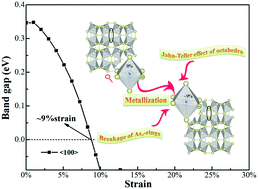当前位置:
X-MOL 学术
›
Inorg. Chem. Front.
›
论文详情
Our official English website, www.x-mol.net, welcomes your feedback! (Note: you will need to create a separate account there.)
Strain-engineering enables reversible semiconductor–metal transition of skutterudite IrAs3
Inorganic Chemistry Frontiers ( IF 7 ) Pub Date : 2019/12/09 , DOI: 10.1039/c9qi01295h Yan Liu 1, 2, 3, 4, 5 , Da Li 1, 2, 3, 4, 5 , Fubo Tian 1, 2, 3, 4, 5 , Defang Duan 1, 2, 3, 4, 5 , Bingbing Liu 1, 2, 3, 4, 5 , Tian Cui 1, 2, 3, 4, 5
Inorganic Chemistry Frontiers ( IF 7 ) Pub Date : 2019/12/09 , DOI: 10.1039/c9qi01295h Yan Liu 1, 2, 3, 4, 5 , Da Li 1, 2, 3, 4, 5 , Fubo Tian 1, 2, 3, 4, 5 , Defang Duan 1, 2, 3, 4, 5 , Bingbing Liu 1, 2, 3, 4, 5 , Tian Cui 1, 2, 3, 4, 5
Affiliation

|
Strain engineering is a more effective and green method to achieve the nonmetal-to-metal transition than metal doping. The elastic strain field can effectively change the atomic orbital interaction, achieving the metallization of materials. Taking IrAs3 as a prototype, the strain–stress behaviors of binary skutterudite are investigated. A reversible semiconductor-to-metal (SM) transition can be easily achieved by only an ∼9% strain. The strain-induced Jahn–Teller effect of IrAs6 octahedra and the breakage of As4-rings dominate the metallization. Unexpectedly, the metal element Ir in IrAs3 becomes an electron acceptor due to its higher electronegativity and the effect of the octahedral field.
中文翻译:

应变工程可以实现方钴矿IrAs3的可逆半导体-金属过渡
应变工程是一种比金属掺杂更有效和绿色的方法,可以实现非金属到金属的过渡。弹性应变场可以有效改变原子轨道相互作用,实现材料的金属化。以IrAs 3为原型,研究了二元方钴矿的应变-应力行为。仅约9%的应变即可轻松实现可逆的半导体到金属(SM)的转变。应变诱导的IrAs 6八面体的Jahn-Teller效应和As 4环的断裂主导了金属化。出乎意料的是,IrAs 3中的金属元素Ir由于其较高的电负性和八面体场的作用而成为电子受体。
更新日期:2020-03-04
中文翻译:

应变工程可以实现方钴矿IrAs3的可逆半导体-金属过渡
应变工程是一种比金属掺杂更有效和绿色的方法,可以实现非金属到金属的过渡。弹性应变场可以有效改变原子轨道相互作用,实现材料的金属化。以IrAs 3为原型,研究了二元方钴矿的应变-应力行为。仅约9%的应变即可轻松实现可逆的半导体到金属(SM)的转变。应变诱导的IrAs 6八面体的Jahn-Teller效应和As 4环的断裂主导了金属化。出乎意料的是,IrAs 3中的金属元素Ir由于其较高的电负性和八面体场的作用而成为电子受体。


























 京公网安备 11010802027423号
京公网安备 11010802027423号